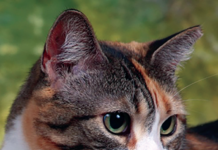The Chartreux – a gentle giant with copper eyes and a dense, wooly blue-gray coat – is one of the three exclusively blue breeds of the cat fancy. The Korat and the Russian Blue share the distinction; these three breeds accept only one coat color.
But Blue cats are not really blue; solid-colored gray cats are simply referred to as blue by cat fanciers. Gray cats have pussy-footed around France for hundreds of years. The Comte de Buffon, the 18th century French naturalist, in his 36-volume Histoire naturelle, identified the Chartreux as one of four cat breeds common in Europe during this time.
Chartreux reportedly rarely meow; this silent, perhaps contemplative kitty is rumored to have lived with the Carthusian monks whose main monastery lies high in an Alpine valley in the Chartreuse mountains near Grenoble, France. Although it is amusing to speculate, there is no documentation to prove that the monks kept these cats or lent them their name.
Natural colonies of these blue-gray cats could be found in France until the First World War. To ensure their survival during these adverse times, French cat breeders selected the best individuals for controlled breeding programs.
The Chartreux made its premier appearance at a cat show in Paris in 1931, exhibited by Mlle. Leger. The hardships most Europeans experienced during World War II took a toll on the continuity of many purebred lines of dogs and cats. In the 1950s, many Chartreux breeders were forced to crossbreed with non-purebred blue cats as well as blue Persians and British blues in order to ensure the survival of the breed.
Twenty years later, with little discernable difference between British blues and Chartreux, the Feline International Federation (FIFe) declared them to be the same breed, only to recant some time later.
Came to the States in 1970
The first Chartreux was imported to the United States in 1970. Today, the Chartreux is recognized by all major breed associations in the United States, as well as the FIFe, which is the major breed association in Europe. Only the governing council of the Cat Fancy (GCCF), the major breed association in the UK, does not recognize the Chartreux as a distinct and unique breed.
Chartreux breeder Carolyn Menzel of Blue Bijou cattery in upstate New York believes the most important thing prospective cat owners can do is research a breeds personality type. Calm, gentle, devoted and sweet are a few of the adjectives Menzel uses to describe her Chartreux.
Her cats will come when they are called and follow her from room to room, especially when a food treat is involved. Chartreux love food more than anything in the world, says Menzel. And perhaps with good reason; male cats can grow to 14-18 pounds, and they take their time doing it.
Males of this slow-maturing breed are reported to take four or five years to reach their adult weight. Females are much smaller, rarely weighing more than 10 pounds. The Chartreux remains a relatively rare breed; last year the Cat Fanciers Association registered less than 300 Chartreux, compared to more than 22,000 Persians or almost 5,000 Maine Coons. If the Chartreux wears a gentle smile, as many fanciers claim, perhaps it is because it has found contentment in its place in the world.



